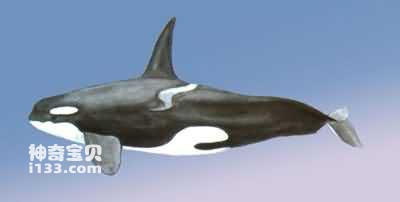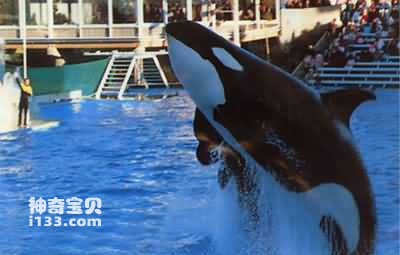Killer whales are also called evil whales and killer whales, and their English name is killer whales. Because it especially likes to eat the fat of baleen whales, so. Norwegians call them "oil thieves". Killer whales are world-famous for their strong physique and ferocious temperament, and are known as the "tyrants of whales". It is strange to say that killer whales are extremely ferocious in the natural sea, but after being conditioned and trained by humans in an artificial breeding environment, they have become very tame and can perform various technical performances according to human instructions (such as diving, jumping, etc.) ball, dancing in the water to music, etc.). Since the late 1960s, they have become famous as "aquatic stars" in ocean parks and water hotels. At the same time, specially trained killer whales can also salvage torpedoes and rockets that have sunk to the seabed according to human instructions.
The most striking thing about killer whales is that they are distributed throughout the world's oceans, and the cold Antarctic and Arctic are their tourist attractions. They can not only live in the hot waters around the equator, but can also freely appear in the polar ice seas that are frozen all year round. Whether they are in the scorching equator or in the icy waters of the South and North Pole, their body temperature remains constant at 36°C. Why is this? The key is that their bodies have a special body temperature regulation device - a heat exchange system. Killer whales rely on this "equipment" to keep their body temperature constant in sea areas with different temperatures.
As we all know, terrestrial mammals rely on the fur on their body surfaces to keep their body temperature constant. Killer whales are mammals that live in the ocean. The speed of heat dissipation in water is 2.5 times that of air, which means that more heat is generated in its body.
The body surface of killer whales is smooth and hairless, and there is a thick layer of fat under the skin. The fat plays a role in insulating against cold erosion. There is no fat layer on its forelimbs, tall dorsal fins, and tail pieces. There are some vascular networks running through these parts, forming a heat exchange system. These parts are exposed to water and have no fat layer, so they are usually as cold as the surrounding water. The blood in the killer whale's body becomes cold when it passes through these places. As the blood in these areas leaves the forelimbs, dorsal fins, and tail blades through veins, it is warmed by the heat of arterial blood flowing from the heart to these areas. The advantage of this approach is that much of the heat is transferred back into the body, rather than all of the heat being lost into the water through the forelegs, back and tail pieces.
In short, the heat exchange system in the killer whale's body can not only prevent the loss of heat in the body, but also diffuse excess heat in the body to the surrounding water environment, thereby regulating the body temperature to remain constant.


animal tags:
We created this article in conjunction with AI technology, then made sure it was fact-checked and edited by a Animals Top editor.